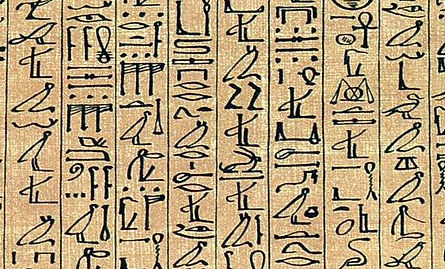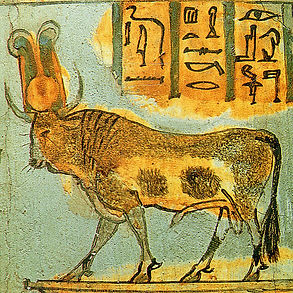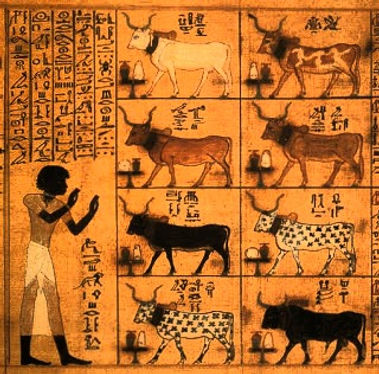



The Cattle Cults of the Ancient Egyptians:
Sophia Flint
In the mysticism that surrounds Ancient Egyptian theology, gods and goddesses were abstract; their forms both interchangeably ethereal deities as well as natural manifestations (Hughes, 20.) In their material forms, Ancient Egyptians believed gods used animals to reveal themselves in the human world so they could be knowable to their worshipers (David, 56.) The development of the bull cults evolved from the agrarian traditions of the Ancient Egypt to gain a special place among the pantheon of gods, both as representations of fertility and as symbols of power.
With evidence of herding seen as early as the Neolithic period, cattle were likely the first animals domesticated by Early Egyptians (Shaw, 28.) Due to their long history with the Ancient Egyptians, cows and bulls were also some of the first to gain religious connotations in their society. The cults surrounding veneration of cattle would later evolve into representations of the god Ptah, the creator of the universe and protector of the city of Memphis; as well as the goddess Hathor, who represented fertility and beauty (David, 54; Shaw, 429 – 430.) Indications of ritual sacrifice are seen at the burial sites near Nabta Playa that date from the Late Neolithic Age. Horns and bull remains are found as offerings and mark the earliest known religious connection cattle had with the Ancient Egyptians(Shaw, 30.) Ian Shaw suggests that due to the climate of Ancient Egypt, livestock like cows could not survive without the development of a civilization capable of sophisticated agrarianism. As a result, cattle as a resource were too valuable to rear for purposes of meat production. Instead, bovine were kept mainly for dairy production and for protein that could be gained from moderate bloodletting (Shaw, 28.) This makes the deliberate killing of the bulls found at Nabta Playa especially poignant. However, the evidence of this early cattle veneration shows support for what would later evolve into the cult of the Apis bull in the Third Intermediate Period (Shaw, 386.)

In Ancient Egypt animal husbandry was also shaped by religion. Many temples fostered animals as venerated incarnations of the gods and often kept their own herds and flocks on the grounds (Hughes, 20.) This practice evolved into some of the earliest development of conservation and selective breeding in Ancient Egypt. Greek historian Herodotus, details this in his work, Histories, which in part chronicles his travels through Egypt in the 5TH century B.C. Here he writes about the careful selection of the Apis bull that was chosen by temple priest as an incarnation animal only after strict criteria was met. “The Egyptians say that fire comes down from heaven upon the cow, which thereupon conceives Apis. The calf which is so called has the following marks: He is black, with a square spot of white upon his forehead, and on his back the figure of an eagle; the hairs in his tail are double, and there is a beetle upon his tongue” (Herodotus, Histories, Book III 28.3.) This animal was not sacrificed, but kept on the temple grounds as an oracle and living proxy for the gods. As such, the bull was provided with his own harem, living quarters and interned with funeral rites at the Serapeum at Memphis when it died (David 316 – 317.)
Many temples kept their own flocks and herds as incarnation animals. Ramses III was said to have given nearly half a million waterfowl to the temples in and around Ancient Egypt. J. Donald Hughes, states that these animals would not have been ritually killed on mass, that they would have been conserved as part of the temple flocks with only a few consumed as food (Huges, 20.) It was not until the Greco-Roman period that animals were bred in Ancient Egypt for sacrificial purposes and was a concept brought to them by the Greeks and Romans (David ,314.)
Cattle had a long history with the Ancient Egyptians. Their value in early agriculture made them a creature worthy of veneration as their civilization evolved. For this reason, both in their cult status and their godly incarnations they remained an esteemed asset in Egyptian society.
Works Cited:
David, Rosalie. Religion and Magic in Ancient Egypt. London: Penguin, 2002.
Hughes, J. Donald. "Sustainable Agriculture in Ancient Egypt." History of Agriculture and the Environment Vol66. No. 2 (Spring 1992): Agricultural History Society: 12-22. JSTOR. Web. <http://www.jstor.org/stable/3743841>.
Shaw, Ian. The Oxford History of Ancient Egypt. Oxford: Oxford University Press, 2000.
